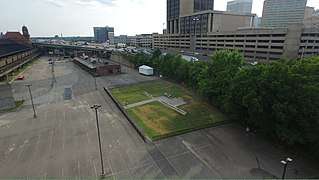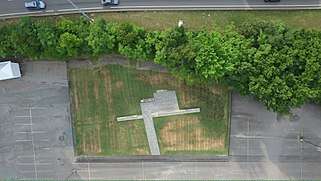Lumpkin's Jail
Lumpkin's Jail, also known as "the Devil's half acre", was a holding facility, or slave jail, located in Richmond, Virginia, just three blocks from where the capitol building sits today. It was active from the 1830s through the Civil War.[1] Robert Lumpkin was a notorious and prominent slave trader who bought and sold slaves throughout the South, and turned Lumpkin's Jail into the largest slave-holding facility in Richmond for well over twenty years.[2]


History
Robert Lumpkin purchased three lots on Wall Street in Shockoe Bottom on November 27, 1844, for roughly six thousand dollars. Although named after Lumpkin, the property had two previous owners and the holding facility had already been established by the time Lumpkin acquired the property.[3] Even though this was already used as a holding facility for slaves, it was not used to the extreme until it came into Lumpkin's possession. Being the largest slave trader in Richmond at the time, he had a flair for cruelty. Those that ran away or tried to escape were publicly beaten or tortured. Inside the jail was "the whipping room." Here slaves were stretched out upon the floor, fastened by their wrists and ankles to iron rings, and flogged.[4] Four other lots on Wall Street (now 15th Street) contained slave jails; the area was collectively referred to as Lumpkin's Alley.[5]

The complex known then as Lumpkin's Jail actually contained four separate buildings, including Lumpkin's residence, a guest house, and a kitchen/bar. The two-story brick "slave pen" was approximately forty feet long.[6] On the bottom floor of that building was the main jail area, which typically held slaves that were next or fit to be sold.[4] It temporarily housed men, women, and children until they were auctioned off to plantation owners. The jail was situated along Shockoe Creek and featured "barred windows, high fences, chained gates opening to the rutted streets, and all seen and smelled through a film of cooking smoke and stench of human excrement."[5] It was said to more closely resemble a chicken coop, holding so many slaves that they were virtually on top of one another. Multiple slaves would be crammed into one room or floor, with no toilets or access to the outside with the exception of a small window. Due to these conditions, slaves at the jail often died of disease or starvation, if not from beatings and torture. Those that died were simply dumped into the area surrounding the jails.[7] This area is now known as the African Burial Ground.[8] The nearby market that sits on the canal and railroad tracks was used as the slave market. This is where slaves were groomed, fed, and dressed up to be sold at auctions on the river. Once bought, they were pushed onto a boat or train and shipped down river to their next destination.[9]
Robert Lumpkin
"He was both an evil man and a family man."[10] Robert Lumpkin, known for his cruelty and mistreatment of slaves. would eventually rape, impregnate, and marry a light-skinned slave that he had purchased: Mary.[11] He fathered five children with Mary, seeing to it that they had the best treatment and education, including sending two of his daughters to finishing school. Before the Civil War ended, he sent his wife and children to Pennsylvania to avoid being sold back into slavery to pay off his debt. When Lumpkin died in late 1866, he left all of his property and land to Mary, who was legally allowed to accept it at the time.[10]
After the Jail
In April 1865 the Union Army captured Richmond, and all slaves were emancipated. In 1867, Mary Lumpkin sold the land to Nathaniel Colver, a Baptist minister looking for a place to establish an exclusively black seminary. The Colver Institute, later Richmond Theological Seminary, and finally Virginia Union University, made use of the buildings for three years. The land went from being colloquially referred to as "the Devil's half acre" to "God's half acre."
The buildings on Lumpkin's lot were destroyed by 1876.[6] Richmond Iron Works was eventually built over the original foundation. Today, the Interstate 95 embankment and a parking lot for university students cover the area.[3] In the mid-2000s archeologists began excavating the site, digging fourteen feet into the earth before finding the jailhouse foundation. Thanks to constant saturation from the adjacent Shockoe Creek, aerobic bacteria which normally break down organic matter were kept at bay. This allowed archeologists to find numerous artifacts left behind such as clothes, shoes, toys, and books, although no whipping rings, iron bars or other artifacts typically associated with slavery were found.[10]
Inmates
Over the twenty years the Lumpkin Jail was in operation, it saw thousands of slaves come and go. The most famous inmate ever known to reside in Lumpkin's Jail was Anthony Burns. Burns had escaped slavery in Virginia, but was arrested in Boston and tried under the Fugitive Slave Law. Though many lobbied for his release, he was sent back to Lumpkin's Jail and held for four more months until abolitionists raised sufficient funds to buy his freedom. Once freed, he returned to the North and became a pastor, but died shortly thereafter at the age of 28.[12]
References
- Tucker, Abigail. "Digging Up the Past at a Richmond Jail". Smithsonian Magazine. Retrieved 27 September 2013.
- Zucchino, David. "With Unearthing of Famous Jail, Richmond Confronts Its Past". Los Angeles Times. Retrieved 30 March 2014.
- Laird, Matthew. "Preliminary Archaeological Investigation of the Lumpkin's Jail Site" (PDF). City of Richmond. Retrieved 3 July 2016.
- Tucker, Abigail. "Digging Up The Past At Richmond Jail". Smithsonian.com. Retrieved 27 March 2014.
- Richardson, Seldon; Maurice Duke (2008). Built by Blacks: African American Architecture and Neighborhoods in Richmond. Charleston, South Carolina: The History Press.
- "Preliminary History of the Lumpkin's Jail Property" (PDF). Richmond City Council Slave Trail Commission. Retrieved 26 February 2015.
- "PRELIMINARY HISTORY OF THE LUMPKIN'S JAIL PROPERTY" (PDF). Retrieved 30 March 2014.
- Noe-Payne, Mallory. "Memorializing the Lumpkin's Jail Site in Richmond". wvtf.org. Retrieved 18 December 2015.
- Zucchino, David. "With unearthing of infamous jail, Richmond confronts its slave past". Los Angeles Times. Retrieved 30 March 2014.
- Tucker, Abigail. "Digging Up The Past At A Richmond Jail". Smithsonian.com. Retrieved 27 March 2014.
- Rhodes, Karl. "Mother of the Domestic Slave Trade" (PDF). Economic History. Federal Reserve Bank of Richmond. Retrieved August 2, 2016.
- Steven, Charles. "PRELIMINARY HISTORY OF THE LUMPKIN'S JAIL PROPERTY" (PDF). Anthony Burns: A History. Retrieved 30 March 2014.